While the discussion below focuses on Collection #9, the steps are generally the same with any of the style collections.
If you have ordered this collection on a USB drive, all the styles will be in a folder called "Styles9". If you have downloaded the collection, you can unzip all the files and put them into a folder called "Styles9". That folder will have 6 folders and two files. The illustration below shows the contents as viewed in a Mac. The PC lisitng would be similar.
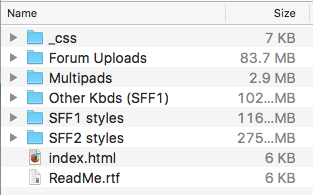 The ReadMe.rtf is a rich text file for use in your PC. Double-click on it for a brief explanation of the collection contents. The Index.html is a web page. Double-click on that to launch your browser and get a web-based description of the contents. The _css folder has instructions to help format that web page.
The ReadMe.rtf is a rich text file for use in your PC. Double-click on it for a brief explanation of the collection contents. The Index.html is a web page. Double-click on that to launch your browser and get a web-based description of the contents. The _css folder has instructions to help format that web page.
The style files will be found in three folders and all the included subfolders: "Other Kbds (SFF1)", "SFF1 styles", "SFF2 styles". The "Multipads" folder holds multipad files. All the style files and the multipad files are meant to be used in your Yamaha keyboard, not in your personal computer. On your computer, you can see the file names for these files, but trying to open them up will not work since your computer may not have an application that can play a style file. An exception would be if you have a Windows PC and you have a program like the PSR Style Dataabase or Michael Bedesem's MidiPlayer program. Both of these programs can read style files on a PC.
SFF1 vs SFFG2
The term "SFF" stands for Style File Format. The newest Yamaha style file format, referred to as SFF2, is used in the Tyros3/4/5 and the PSR-S910/950/970. The earlier format was used in the Tyros1/2 and the PSR-2000/2100/3000 and PSR-S900. If you have one of these earlier keyboards, you will not be able to read SFF2 files directly. If you have a newer keyboard, you can read both the SFF2 and SFF1 style file formats. So, owners of newer keyboards can read all the styles in this collection. Owners of older keyboards will not be able to read the files in the "SFF2 styles" folder. However, Jørgen Sørensen's Style Format 2 Converter can be used to convert SFF2 styles to the SFF1 format.
Files on the PC
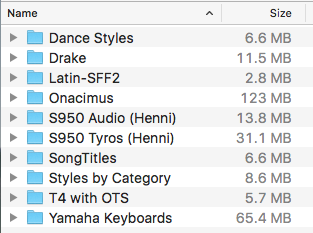 You can examine the structure of this file organization on your personal computer. If you were to open the "SFF2 styles" folder, you would see 10 subfolders as shown in this illustration but still no styles. The subfolders give you an idea of where the styles originated. For example, the "Drake" folder are styles from Drake's Style Collection. Open up that folder and you see two subfolders: "S950 YEP conversions" and "S950 SongTitles". These styles were created on the PSR-S950 but they would, of course, play perfectly fine on other PSR-S keyboards or the latest Tyros models.
You can examine the structure of this file organization on your personal computer. If you were to open the "SFF2 styles" folder, you would see 10 subfolders as shown in this illustration but still no styles. The subfolders give you an idea of where the styles originated. For example, the "Drake" folder are styles from Drake's Style Collection. Open up that folder and you see two subfolders: "S950 YEP conversions" and "S950 SongTitles". These styles were created on the PSR-S950 but they would, of course, play perfectly fine on other PSR-S keyboards or the latest Tyros models.
The "S950 YEP conversions" folder includes four subfolders: "Best of Europe styles", "Celtic Northern Europe styles", "Church & Christmas styles", and "Mexican Banda". Opening any of these subfolders will, finally, bring you to the actual style files.
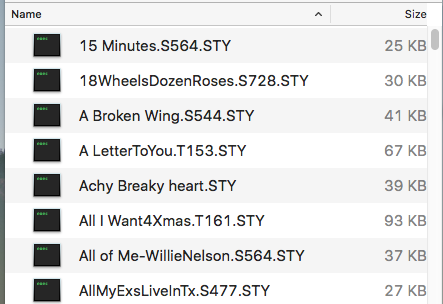 The "S950 Song Titles" folder includes 146 styles. Each of these are named after a particular song title and are tuned for use with that song. Note that these are only style files, you have to be able to actually play the song, but the style is the one that Drake used when he performed that song. In the illustration shown here, only the first 8 songs in the listing are shown. You would scroll down the list to see all the available songs in this folder.
The "S950 Song Titles" folder includes 146 styles. Each of these are named after a particular song title and are tuned for use with that song. Note that these are only style files, you have to be able to actually play the song, but the style is the one that Drake used when he performed that song. In the illustration shown here, only the first 8 songs in the listing are shown. You would scroll down the list to see all the available songs in this folder.
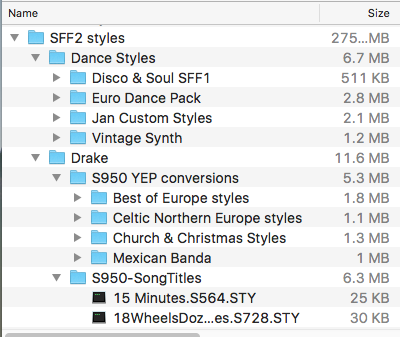 The above procedure shows how you would get to the styles from your personal computer. You simply open the folder, and then one or more sub-folders, and you eventually come to a listing of styles. The figure shown here illustrates the folder hierarchy. The "S950-SongTitles" is open and the styles are listed there. If any of the shown folders were to be opened, you would see the included styles in that folder. The "Best of Europe styles" includes 40 styles. "Church & Christmas Styles" has 30 styles. There are 42 styles in the "Jan Custom Styles" folder.
The above procedure shows how you would get to the styles from your personal computer. You simply open the folder, and then one or more sub-folders, and you eventually come to a listing of styles. The figure shown here illustrates the folder hierarchy. The "S950-SongTitles" is open and the styles are listed there. If any of the shown folders were to be opened, you would see the included styles in that folder. The "Best of Europe styles" includes 40 styles. "Church & Christmas Styles" has 30 styles. There are 42 styles in the "Jan Custom Styles" folder.
Files on your Yamaha
If all of these folders and styles are copied to a USB and the USB is placed in your Yamaha keyboard, you would acces the styles in a similar fashion. However, there is one very big difference between your your Yamaha sees the file organizaiton and your personal computer does. The PC will show you all the filers and the contents of each folder. Your Yamaha will show you all the folders, but the only contents you will see are restricted to the kind of file you are looking for. If you have a folder that includes style files and midi files and registration files and you are trying to load a "STYLE" file, the Yamaha will show you the style files but it will NOT SHOW YOU any of the song files or registration files. If you were trying to load a midi song and you were looking at the "SONG" screen, you would see all the folders and all the midi files, but you would not see any style files or registration files.
The Yamaha file system is explained more thoroughly in the lesson on the "Yamaha File System", which is available in the Lessons area. If the Yamaha and "files" are new to you, it would be a good idea to review that lesson.
Style Files
With the USB in your keyboard, to load a style file you first need to access the "STYLE" screen. You can get there in either of two ways. On your keyboard, no matter what model you have, there are a series of buttons for the various style categories (Pop&Rock, Ballad, etc). Press any of these buttons and you immediately bring up the STYLE screen. It will be showing you styles in the particular style category that matches the button you pushed. You can tell you are on the STYLE screen because at the very top of the screen, centered on the first line, will be the word STYLE.
Right below that will be a series of tabs. If you used one of the category buttons to bring up this screen, you will be in the PRESET tab. That is showing you styles that are in the PRESET area. This is where all the styles that came with your keyboard are stored. You can load styles from this area, but you can not add to or delete any of the styles in this area. They are permanently part of your keyboards hardware.
There are other storage areas that can hold your styles. Right next to the PRESET tab will be a tab for USER styles. This is the "User" area and you can save any style you want in this area including styles that you have modified in some way. You could load a preset style, change the one-touch-setting voices, and then save this modified style in the USER area and you then have your own version of that preset style. The USER area is quite limited. It used to be no more than what could be saved on a floppy disk, although the later keyboards have provided a bit more space than that.
If you happen to have a Tyros model, the next tab is labeled HD1. This represents the hard drive that is included with the Tyros3/4/5 models. This provides you with an enormous space in which you can load whatever styles or other files you may want to save in your keyboard. Finally, if you have inserted that USB drive into your keyboard, you now have yet another tab available, labeled USB1. If you tab over to the USB1 area, you will be able to see what is on the USB drive.
Before we tab over to that drive, let's take a look at the second way to get to the STYLE screen. Each of the Yamaha keyboards displays a MAIN screen that shows you the voices that are currently loaded as well as the style loaded. You can always get to the MAIN screen by pressing the EXIT button on your keyboard repeatedly until the MAIN screen appears.
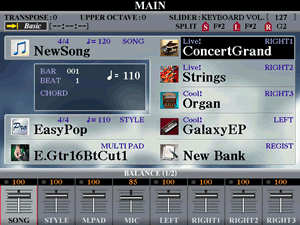 There are 10 boxes of information shown on the main screen, five on the left and five on the right. The top left box, next to the "A" button, usually shows "NewSong". This is where any midi file that may be loaded into your keyboard would display. The top right-hand box usually shows the RIGHT1 voice and the "F" button corresponds to that box. Where the currently loaded style is, depends on what keyboard you have. On the Tyros3 (shown here), Tyros4, and Tyros5 models, the 4th box on the left shows the style - EasyPop in this illustration. It is accessed by pressing the "D" button. On the PSR-S910, S950, and S-970, the style is shown in the 5th box on the left and is accessed with the "E" button. Pressing the style button takes you immediately to the STYLE screen that holds whatever style is currently loaded. There is a separate lesson on "Selecting Styles" that you may find useful.
There are 10 boxes of information shown on the main screen, five on the left and five on the right. The top left box, next to the "A" button, usually shows "NewSong". This is where any midi file that may be loaded into your keyboard would display. The top right-hand box usually shows the RIGHT1 voice and the "F" button corresponds to that box. Where the currently loaded style is, depends on what keyboard you have. On the Tyros3 (shown here), Tyros4, and Tyros5 models, the 4th box on the left shows the style - EasyPop in this illustration. It is accessed by pressing the "D" button. On the PSR-S910, S950, and S-970, the style is shown in the 5th box on the left and is accessed with the "E" button. Pressing the style button takes you immediately to the STYLE screen that holds whatever style is currently loaded. There is a separate lesson on "Selecting Styles" that you may find useful.
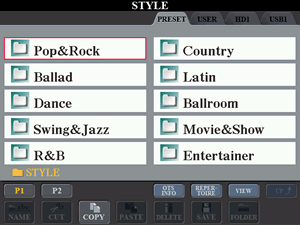 Once you are on the STYLE screen, tab over to USB1. That will show you the folders on the USB drive. If you see just the "Styles9" folder, open it up to see the included subfolders. To get to Drake's county song styles, you would next open up the "SFF2 Styles" folder. Then you would open up the "Drake" folder and, finally the "S950-SongTitles" folder. Now you can see all of the styles in that folder. You may have to use the bottom buttons to page through all the available songs. When you find a song style you want to dry, just double-click on the button next to that song name to automatically LOAD the style and then return you to the MAIN screen. The style is now loaded into your keyboard and you can begin playing it.
Once you are on the STYLE screen, tab over to USB1. That will show you the folders on the USB drive. If you see just the "Styles9" folder, open it up to see the included subfolders. To get to Drake's county song styles, you would next open up the "SFF2 Styles" folder. Then you would open up the "Drake" folder and, finally the "S950-SongTitles" folder. Now you can see all of the styles in that folder. You may have to use the bottom buttons to page through all the available songs. When you find a song style you want to dry, just double-click on the button next to that song name to automatically LOAD the style and then return you to the MAIN screen. The style is now loaded into your keyboard and you can begin playing it.
If you like that style, you may want to SAVE it so that it is easy to find when you want it. You can save it in the USER area, or create a folder of your "favorite" styles on your hard drive and save it there. If you need help on saving a file (or copying a file from one place and putting it somewhere else), check out the lesson on "File Operations". Other lessons in that section will help you learn how to copy whole folders of songs from the USB drive to your USER area or to your hard drive.
If you are just beginning to store things on your hard drive, it might be useful to check out the Workshop on Organizing files, which will give you some ideas on how you might want to organize the folders on your hard drive or on a USB drive.
You can explore the other style files on the USB drive by checking out the contents of the "SFF1 styles" folder and the "Other kbds(SFF1)" folder. However, if you open up the "Multipads" folder from the STYLE screen, you will not see any files. To see the multipad files, you must access that folder from the MULTIPAD screen.
Multipad Files
Look at the MAIN screen again. On the Tyros3/4/5, the current multipad is shown in the 5th box on the left, next to the "E" button. On the PSR-S models, look to the 4th box on the right, next to the "I" button. Press that multipad button and you are taken to the MULTIPAD screen. From here, just tab over to USB1. Open the "Styles9" folder and then the "Multipads" folder. You will see nine subfolders with a total of over 1,360 multpads.
- E L Multipads (61 pads from Eileen Lowry)
- Mark (140 pads from Mark)
- Onacimus (247 pads in 11 folders)
- S910 Multipads (123 pads)
- S950 Multipads (126 pads)
- S970 Multipads (188 pads in 12 folders)
- Tyros3 pads (123 pads)
- Tyros4 pads (164 pads)
- Tyros5 pads (190 pads)
Keep opening the subfolders until you finally reach a list of multipads. Double-click on any multipad and that will load it into your memory and take you back to the MAIN screen.
This page updated on October 3, 2022.
[top]